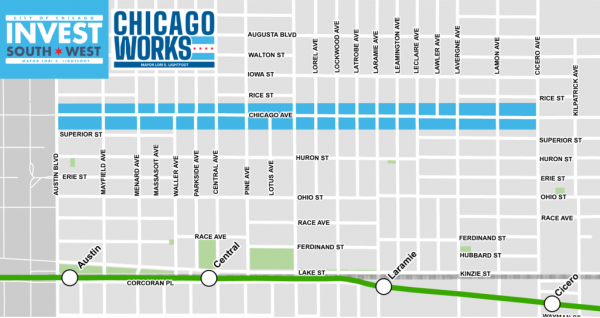New benches and trash cans. Custom bike racks and planters with hanging baskets. Upgraded crosswalks and countdown traffic signals. Wider sidewalks and new streetlights.
All this and more is being considered for the Soul City Corridor, a stretch of Chicago Avenue that runs from Cicero Avenue to Austin Boulevard, as part of the city’s INVEST South/West initiative. The Soul City Corridor is one of 12 key commercial corridors in 10 neighborhoods across Chicago that is targeted for improvements and investment.
The Chicago Department of Transportation and Alds. Chris Taliaferro (29th) and Emma Mitts (37th) hosted a meeting last month about the Austin corridor improvement project. It’s the first of three public briefings planned in coming months.
The goal of the $21 million project is to provide a safe, walkable and attractive street that will foster community and economic growth.
“I’m excited to see this work coming to the West Side on Chicago Avenue, which is going to make things look a bit different around here,” Ald. Mitts said.
Ald. Taliaferro said the Austin corridor project is being coordinated with the Chicago Department of Planning and Development, which is redeveloping the historic Laramie State Bank at 5200 W. Chicago Ave. That $37.5 million project will transform the 92-year-old building into a museum, café and incubator; the winning proposal was one of the first projects given the green light under INVEST South/West.
The Austin corridor improvement project will include permanent identifiers, like a major gateway on Chicago Avenue at either Austin or Cicero, said Lubka Benak, a project director for the city’s transportation department.
She said the city will work with the community throughout the design process. The city will be seeking input from local residents through a project survey, and there also will be interviews with community stakeholders, Benak said.
Bidding for the project will happen in mid-2022, with construction beginning the fourth quarter of next year. There will be several segments of construction that continue through the end of 2024, Benak said.
Lesley Roth, a principal with Lamar Johnson Collaborative and a member of the planning and development department’s new Committee on Design, said they have been drawing from previous work like the Austin Coming Together quality-of-life plan and the more recent Soul City Corridor Plan.
She noted that some of the earlier recommendations – which include plazas and parklets; bus stop amenities; and pedestrian crossing safety features like intersection activations – are being considered. They are asking residents: “What does Soul City mean to you, and how can it be represented along the corridor?”
One priority identified by Austin’s artist in residence, Antonia Ruppert, is ensuring there is a consistent and cohesive look to the several blocks of Chicago Avenue being improved, Roth said. Unified awnings and signs would help accomplish this. And there needs to be places for people to sit.
“Chicago Avenue really needs to have a concentration of energy,” Roth said. “There’s a need for the corridor to be brighter.”
Traffic safety also is being taken into account.
The CTA’s No. 66 bus, which runs on Chicago Avenue from the lakefront to Austin Boulevard, is the third-most traveled route in the city, said Mike Folkening, director of urban design and traffic at Civiltech Engineering Inc.
An analysis of traffic speed and the number of vehicles that travel on Chicago Avenue will help determine what improved safety measures can be taken, he said. Curb bump outs, bus boarding islands and bike lanes are all being considered.
“Our goal is to keep the speeds around 30 mph” to minimize crashes,” Folkening said, noting there are about 180 crashes a year along that stretch of road.
